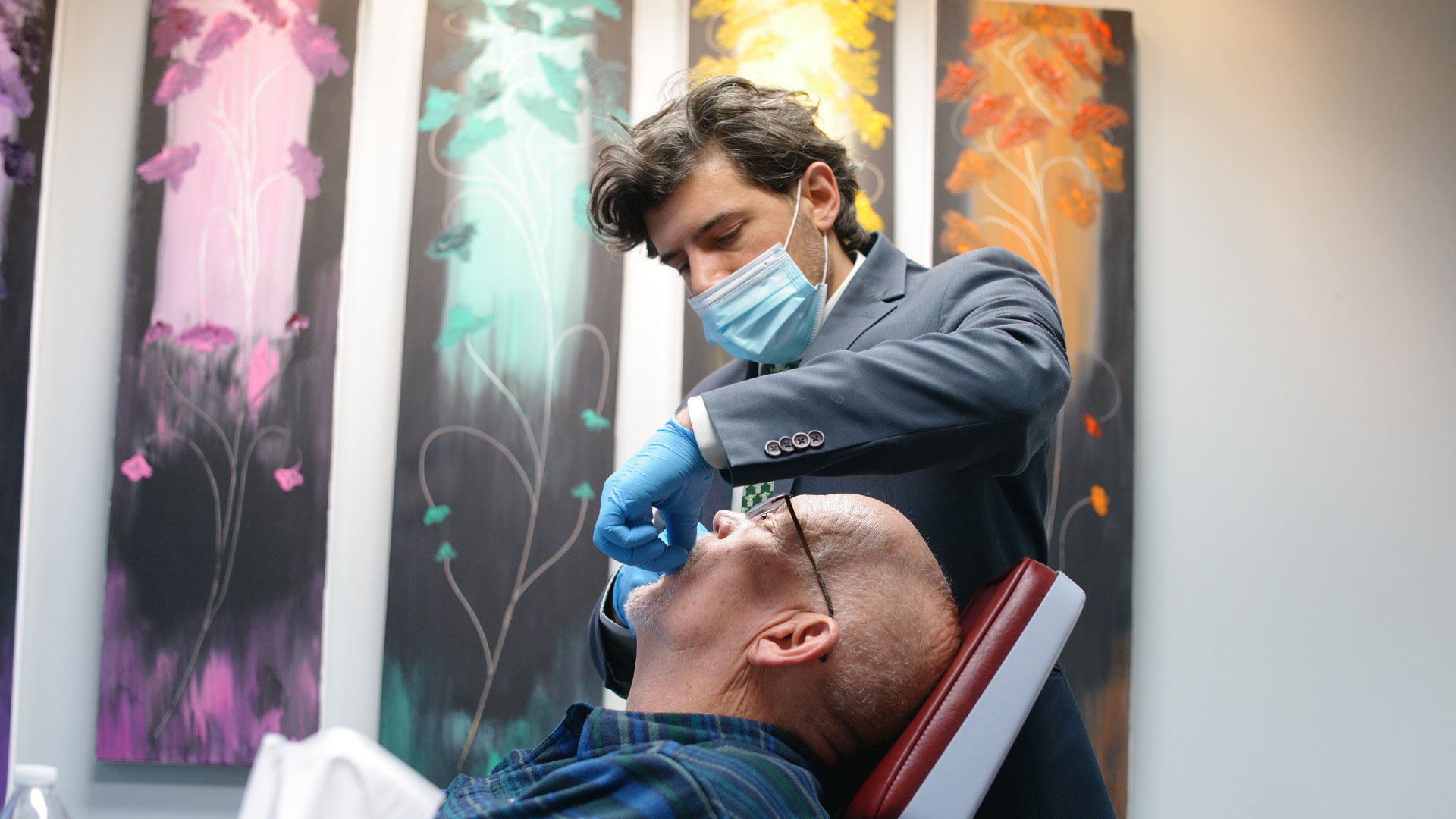Comprehensive orthodontics is a specialized branch of dentistry that focuses on correcting malaligned teeth, improving bite and function, and enhancing overall oral health. At Daia Orthodontics & TMJ Orthopedics, we understand the importance of a beautiful, functional smile and are committed to providing personalized comprehensive orthodontic treatment for patients of all ages.
What is Comprehensive Orthodontics?
Comprehensive orthodontics is a personalized journey towards a radiant and healthy smile. It begins with a meticulous assessment of your dental health, considering factors beyond mere aesthetics. In addition to straightening malaligned or overcrowded teeth, it also addresses functional issues related to the bite, reducing the risk of oral health problems such as cavities, gum disease, and jaw discomfort. There can be many misconceptions about Orthodontics, check out our blog on the 7 Common Myths About Orthodontics!
Conditions Treated by Comprehensive Orthodontics
Comprehensive orthodontic treatment can address a wide range of dental and jaw-related issues, including:
- Crowded or overlapping teeth
- Gaps or spaces between teeth (diastema)
- Underbite, overbite, or crossbite
- Malaligned jaws or teeth
- Midline Discrepancy
- Trauma caused by bite issues
- Too much or too little smile/gums
- And a spectrum of other related conditions

Comprehensive Orthodontics Treatment Options
Orthodontic treatment isn’t solely about enhancing appearance; it’s crucial for maintaining overall oral health. Addressing malalignments can prevent future dental issues like decay, uneven wear, and gum disease. Furthermore, proper alignment improves bite function, reducing the risk of jaw discomfort and potential temporomandibular disorders (TMD) and TMJ pain. At Daia Orthodontics & TMJ Orthopedics, we offer a variety of comprehensive orthodontic treatment options to suit your individual needs and preferences:
- Metal Braces: These tried-and-true braces use high-tech metal brackets and wires to gradually shift teeth into their desired positions.
- Clear Ceramic Braces: For those seeking a more discreet option, clear ceramic braces blend seamlessly with your natural tooth color, providing an aesthetically pleasing alternative to traditional braces.
- Invisalign and Spark Clear Aligners: This customized clear aligner therapy use a series of removable, virtually invisible aligners to gently guide your teeth into their proper positions.
- Archwires: Archwires are an essential component of orthodontic treatment, providing the necessary force to guide tooth movement in both traditional braces and clear aligner systems.
- Elastics (Rubber Bands): Elastics, also known as rubber bands, may be used in conjunction with braces or aligners to address specific bite issues and achieve optimal results.
- Lingual Braces: Lingual braces are placed on the inside surface of your teeth, making them virtually invisible from the outside. They provide effective tooth movement while maintaining a discreet appearance. A great example of these type is the Incognito lingual braces, which Daia Orthodontics & TMJ Orthopedics offers.
- Self-Ligating Braces: Self-ligating braces utilize specialized brackets that do not require elastic or metal ligatures to hold the archwire in place. This technology can result in faster treatment times and fewer adjustments. Daia offers the Damon Ultima self-ligating bracket, known for providing precise control over orthodontic movement and enhanced comfort for patients while using specialized bracket design.
- Myobrace: Designed to combat myofunctional habits in children, Myobrace is a series of intraoral appliances that are worn one hour each day and overnight to help teach proper breathing methods, correction of tongue placement, swallowing correctly, and widening of the jaws for optimal development.
- Retainers: There are different types of retainers, ranging from regular removable retainers that are composed of metal and acrylic, some that are wrap-arounds that are transparent plastic, and even bonded retainers that permanently attached. Let’s go over the key differences between these three. If you want to learn more about the importance of retainers check out our blog!
- Essix retainers which are made of transparent plastic or polyurethane that fits over the teeth compared to traditional retainers that are metal wires and acrylic plates.
- Hawley retainers are the classic removable retainers that are composed of acrylic plates and metal wires that are custom fitted to the roof of your mouth and or bottom of your mouth.
- Bonded/Fixed retainers, similar to lingual braces, these retainers are permanently attached to the back of the teeth using a thin wire. These retainers are beneficial to some as they are nearly invisible to others that are durable and can never been misplaced or lost.
- Additional Appliances: In some cases, additional appliances such as headgear, expanders, face masks, or functional appliances may be recommended to supplement orthodontic treatment and achieve desired results.
In certain complex cases, Dr. Daia may collaborate with trusted specialists and surgeons such as but not limited to periodontists, prosthodontist, restorative dentists, ENTs, Pediatricians, and family physicians to explore additional treatment avenues. Dr. Daia does this to ensure you are provided the most comprehensive care tailored to your unique orthodontic needs. If you want to learn more about all the different braces and clear aligners, check out our blog, The Ultimate Guide to Braces and Clear Aligners. (INSERT LINK WHEN LIVE)
Your Treatment Journey
The duration of comprehensive orthodontic treatment can vary from 12 to 24 months, depending on the severity of your case and compliance with treatment instructions. However, according to the American Association of Orthodontists, adult treatment may take slightly longer than adolescent treatment due to the maturity and density of adult bone tissue. During this time, the team will closely monitor your progress, making necessary adjustments to ensure optimal results. Let’s expand on what your treatment journey may look like.
- Initial Consultation: The journey typically starts with an initial consultation with an orthodontist. During this visit, the orthodontist will conduct a thorough examination of your teeth, jaws, and bite, often using X-rays and photographs to assess your dental alignment and oral health.
- Treatment Planning: Based on the findings from the initial consultation, the orthodontist will develop a personalized treatment plan tailored to address your specific needs and goals. This plan may involve discussing different treatment options, such as traditional braces, clear aligners, or other orthodontic appliances.
- Commencement of Treatment: Once a treatment plan is agreed upon, the orthodontic treatment begins. This typically involves the placement of braces or aligners to gradually move your teeth into their desired positions. Your orthodontist will provide instructions on how to care for your braces or aligners and any dietary restrictions to follow during treatment.
- Accelerated Orthodontics: Discover advanced techniques such as micro-osteoperforations and innovative devices, offering the potential to halve treatment duration while minimizing office visits. Learn about the exciting possibilities of accelerated orthodontics in our blog, Technologies in Accelerated Orthodontics.
- Monitoring Progress: Throughout the treatment process, regular appointments with your orthodontist can be scheduled to monitor your progress in person or virtual treatment monitoring may be implemented. At Daia Orthodontics & TMJ Orthopedics, we have access for company dental monitoring and Invisalign systems so that you may have the option to continue your monitoring process virtually. Regardless, these appointments are crucial when making any necessary adjustments to your braces or aligners. It helps ensure that treatment is progressing properly and is achieving the desired results.
- Maintenance and Retention: After your teeth have been successfully aligned, the next phase of the orthodontic journey begins – retention. Retention involves wearing retainers to help maintain the new position of your teeth and prevent them from shifting back to their original alignment. Your orthodontist will provide guidance on how often to wear your retainers and for how long to ensure long-term stability.
Maintaining Your New Smile
Once your comprehensive orthodontic treatment is complete, it’s essential to follow the team’s instructions for retaining your newly aligned smile. As mentioned above, retainers may be prescribed to prevent your teeth from shifting back to their original positions, ensuring your investment in a beautiful, healthy smile is protected. You can learn more about The Importance of Wearing Your Retainers here.
In addition to wearing your retainers as instructed, maintaining good oral hygiene habits is crucial. This involves brushing your teeth at least twice a day, using water picks, flossing daily, and using mouthwash to keep your mouth clean and free of plaque and bacteria. Proper oral hygiene not only helps prevent dental issues such as cavities and gum disease but also contributes to the longevity of your orthodontic results.
Furthermore, it’s important to be mindful of your diet and avoid foods that can damage your teeth or orthodontic appliances. Sticky, hard, or sugary foods can potentially cause damage to your braces or aligners and increase the risk of tooth decay. Your orthodontist may provide you with a list of foods to avoid or recommend modifications to your diet during treatment and retention. Regular visits to your orthodontist for check-ups are also crucial for maintaining your new smile. These appointments allow your orthodontist to monitor the stability of your results and address any issues that may arise promptly. By staying proactive and attending regular appointments, you can ensure that your smile remains healthy and beautiful for years to come. Our blog, Comprehensive Orthodontics and How to Maintain New Braces, goes in more details on how to maintain your new smile.
Additional Advice
Ensuring the longevity of your orthodontic treatment involves more than just wearing retainers and maintaining good oral hygiene. It’s essential to protect your teeth during physical activities by wearing a mouthguard and avoiding bad oral habits like nail biting or using your teeth as tools. Consistency in oral care is crucial, so make sure to follow your orthodontist’s instructions diligently and stay hydrated to keep your mouth healthy.
Additionally, seek prompt attention for any issues that arise, such as discomfort or unusual changes in your treatment. Mind your tongue’s position, especially with lingual braces, and stay positive throughout your orthodontic journey. Remember, staying proactive and adhering to these additional pieces of advice will contribute to the success of your treatment and ensure a beautiful, healthy smile for years to come.

At Daia Orthodontics & TMJ Orthopedics, we prioritize your overall oral health and comfort throughout your comprehensive orthodontic journey. Our state-of-the-art facility is equipped with cutting-edge imaging technology, allowing us to comprehensively view your teeth’s orientation and surrounding structures in 3D. This digital imaging guides our personalized treatment plans, ensuring you achieve the beautiful, pain-free, functional smile you’ve always wanted.
If you’re ready to embark on your comprehensive orthodontic journey, contact Daia Orthodontics & TMJ Orthopedics today to schedule your consultation. Our team of experts is dedicated to helping you achieve a radiant, healthy smile that will last a lifetime.




